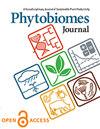Mycobiome shifts in Ulmus minor stems after infection with beneficial and pathogenic fungi
IF 2.6
3区 生物学
Q2 MICROBIOLOGY
引用次数: 0
Abstract
The assembly of plant microbial communities is a complex process orchestrated by plant physiology and microbial interactions under changing environmental conditions. In this work we aim to disentangle how an aggressive vascular pathogen, Ophiostoma novo-ulmi, affects the composition of the resident mycobiome of field elm (Ulmus minor). We also aim to determine the extent to which the inoculation of beneficial endophytes buffers the changes induced by the pathogen in the resident mycobiome composition. Three U. minor genotypes, two resistant and one susceptible to O. novo-ulmi, were inoculated with i) the pathogen, ii) a consortium of three beneficial endophytes, or iii) the endophyte consortium followed by pathogen inoculation. Endophyte composition of stem samples was profiled by high throughput sequencing of the first internal transcribed spacer region of the ribosomal DNA. A total of 365 ASVs were obtained, 61 of which were core members. Pathogen colonization reduced the ASV richness while endophyte inoculation increased the Shannon diversity. In most cases, the endophyte consortium inoculation prevented most of the changes in the mycobiome composition induced by the pathogen. At the genotype level, both alpha and beta diversity varied strongly, with latent pathogens being more abundant in the susceptible genotype. Overall, the results evidence that inoculation of plant beneficial endophytes buffers the changes produced in the mycobiome by aggressive pathogens.Ulmus小茎感染有益真菌和致病真菌后的真菌群落变化
在不断变化的环境条件下,植物微生物群落的组装是一个由植物生理学和微生物相互作用协调的复杂过程。在这项工作中,我们的目的是弄清楚一种侵袭性的血管病原体,新榆树是如何影响野榆树(小榆树)常驻真菌群落的组成的。我们还旨在确定接种有益内生菌在多大程度上缓冲病原体在常驻真菌生物群落组成中诱导的变化。用i)病原体,ii)三种有益内生菌的联合体,或iii)内生菌联合体接种病原体,然后接种病原体。通过对核糖体DNA的第一个内部转录间隔区进行高通量测序,对茎样品的内生植物组成进行了分析。共获得365个ASV,其中61个是核心成员。病原体定殖降低了ASV的丰富度,而内生菌接种增加了Shannon的多样性。在大多数情况下,内生菌联合体接种阻止了病原体诱导的真菌生物群落组成的大部分变化。在基因型水平上,α和β多样性差异很大,易感基因型中潜伏病原体更为丰富。总体而言,研究结果表明,接种有益于植物的内生菌可以缓冲侵袭性病原体在真菌生物群落中产生的变化。
本文章由计算机程序翻译,如有差异,请以英文原文为准。
求助全文
约1分钟内获得全文
求助全文

 求助内容:
求助内容: 应助结果提醒方式:
应助结果提醒方式:


